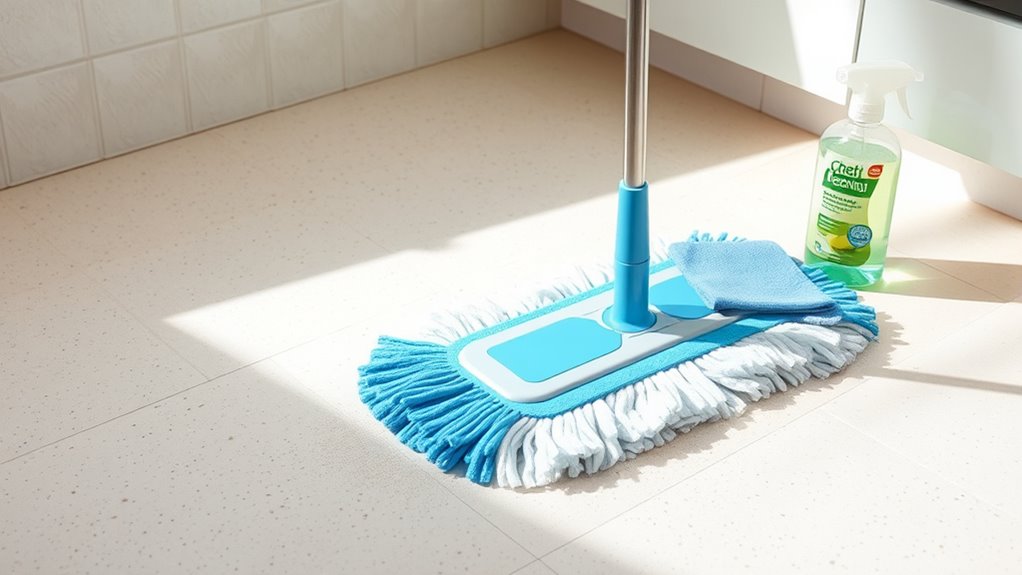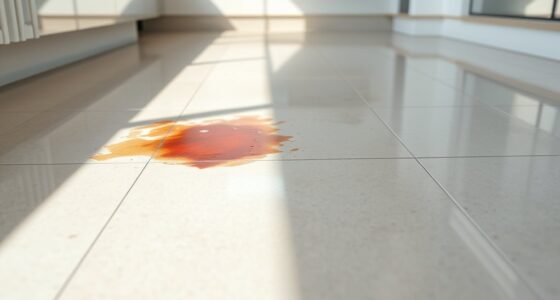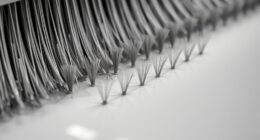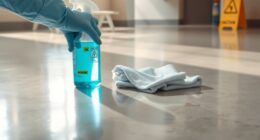To manage dust safely on linoleum floors, regularly vacuum with a high-quality HEPA filter to trap allergens and prevent dust buildup. Maintain your vacuum by cleaning filters and brushes, and vacuum twice to three times weekly, focusing on edges and corners. Use doormats and encourage shoe removal to reduce dirt entry. Incorporate damp mopping and air purifiers for extra dust control. Keep your routine consistent, and you’ll discover more tips for a healthier, allergen-free home.
Key Takeaways
- Use a HEPA-filtered vacuum and clean filters regularly to remove dust effectively and improve indoor air quality.
- Vacuum linoleum floors 2-3 times weekly with slow, overlapping passes, focusing on edges and corners.
- Follow vacuuming with damp microfiber mopping to pick up residual dust and allergens.
- Minimize dust entry by using doormats, removing shoes, and reducing clutter in the space.
- Incorporate air purifiers with HEPA filters to capture airborne dust particles and enhance allergy safety.

Are you struggling to keep dust off your linoleum floors? If so, you’re not alone. Dust tends to settle quickly on smooth surfaces like linoleum, making it seem like a constant battle. The key to managing dust effectively starts with proper vacuum maintenance. When your vacuum is in good shape, it performs better at trapping dust and allergens, preventing them from recirculating into the air. Regularly check and replace filters, ensure the brush roll is clean, and make sure the seals are tight. A well-maintained vacuum creates a powerful suction that pulls up dust particles from the surface without just pushing them around. Choosing a vacuum with a HEPA filter can considerably boost allergen reduction, especially if you or your family members suffer from allergies or asthma. This type of filter captures microscopic particles that standard filters might miss, helping to improve indoor air quality.
To keep your linoleum floors dust-free and allergy-safe, make vacuuming a regular part of your routine. Aim to vacuum at least two to three times a week, more often if you have pets or if dust tends to build up quickly. When vacuuming, go slowly and overlap your passes to ensure you pick up every bit of dust and debris. Pay close attention to edges and corners where dust tends to accumulate. After vacuuming, you can follow up with a damp mop to pick up any remaining particles. Use a microfiber mop or cloth that traps dust rather than spreading it around. Avoid soaking the floor excessively, as too much moisture can damage linoleum over time. Additionally, proper vacuum maintenance enhances dust trapping efficiency and prolongs the lifespan of your equipment.
In addition to regular vacuuming and mopping, consider implementing other dust control measures. Use doormats at entrances to catch dirt and dust before it gets tracked inside. Encourage family members to remove shoes before walking on linoleum floors. Keep clutter to a minimum to reduce hiding spots for dust and allergens. Air purifiers equipped with HEPA filters can also help remove airborne dust, further reducing allergen levels in your home. By maintaining your vacuum properly and establishing a consistent cleaning routine, you’ll create a cleaner, healthier environment. Your linoleum floors will look better, and your indoor air quality will improve, making your space more comfortable and allergy-friendly. Dust control isn’t a one-time task; it’s a continuous effort that pays off with a fresher, healthier home.
Frequently Asked Questions
Can Vinegar Be Used Safely for Dust Control on Linoleum?
Yes, vinegar is safe for dust control on linoleum floors when used properly. Vinegar safety is well-established, and it’s an effective, natural dust control method. Mix equal parts water and vinegar to create a gentle cleaning solution that helps trap dust without harsh chemicals. Use a damp mop, avoiding excess moisture, to clean the floor regularly. This routine keeps your linoleum dust-free and allergy-safe, ensuring a healthier home environment.
How Often Should I Replace My Dust Mop for Allergy Safety?
Ever wondered how often you should replace your dust mop for allergy safety? You should replace your dust mop every 2 to 3 months, depending on its dust mop lifespan and usage frequency. Regular replacement prevents dust buildup and allergens, keeping your environment safer. Do you notice the mop’s fibers fraying or it no longer traps dust effectively? If so, it’s time for a new one to maintain a clean, allergy-safe space.
Are There Specific Vacuum Filters Recommended for Linoleum Floors?
Yes, for linoleum floors, you should choose vacuums with HEPA filters because of their allergy-safe benefits. Look for vacuums that use HEPA filter advantages to trap tiny dust particles effectively. Additionally, consider vacuum bag types that are sealed and designed for allergy sufferers, as they prevent dust from escaping during disposal. This combination ensures cleaner floors and a healthier environment, especially if you have allergies or sensitivities.
Does Using a Steam Mop Help Reduce Allergens Effectively?
Imagine the relief of a cleaner, allergen-free home. Steam cleaning effectively reduces allergens on linoleum floors by using high-temperature vapor, which loosens and lifts dust and debris. This method not only sanitizes but also enhances allergen removal, making your space safer for allergy sufferers. So yes, a steam mop helps markedly in allergen removal, providing a healthier environment while giving you peace of mind.
What Are Natural Alternatives to Chemical Cleaning Products?
You can opt for natural alternatives like plant-based cleaners and homemade solutions to avoid chemicals. Mix equal parts water and white vinegar for a gentle, effective cleaner or add a few drops of essential oils like tea tree or eucalyptus for extra disinfectant power. Baking soda also works well as a scrub or deodorizer. These options keep your linoleum floors clean and allergy-safe without relying on harsh chemical products.
Conclusion
By regularly sweeping and damp-mopping your linoleum floors, you can effectively reduce dust without harsh chemicals. Some might worry it’s too time-consuming, but these simple steps quickly become a daily habit, keeping your home allergy-safe and spotless. Plus, you don’t need special products—just basic supplies. Consistency is key, and soon, you’ll enjoy a cleaner, healthier space where dust won’t bother your allergies. Keeping your floors dust-free is easier than you think!









